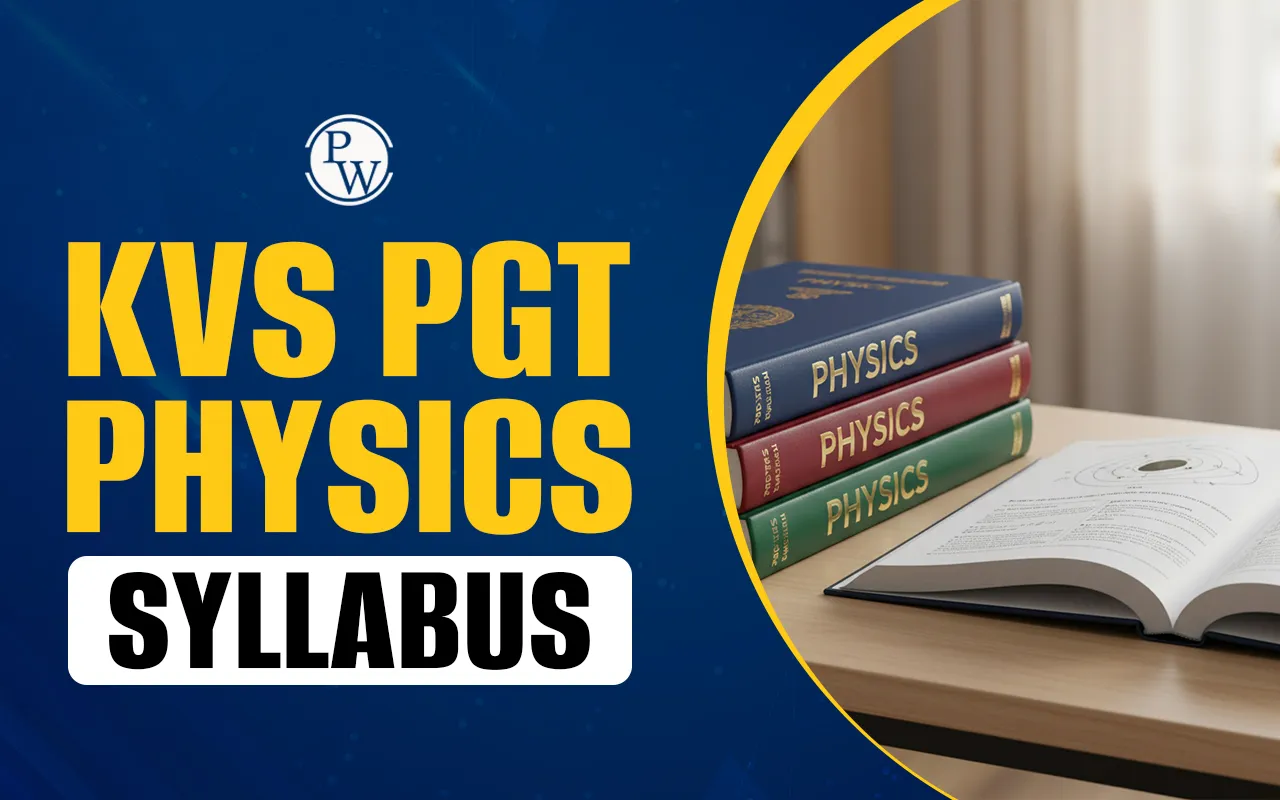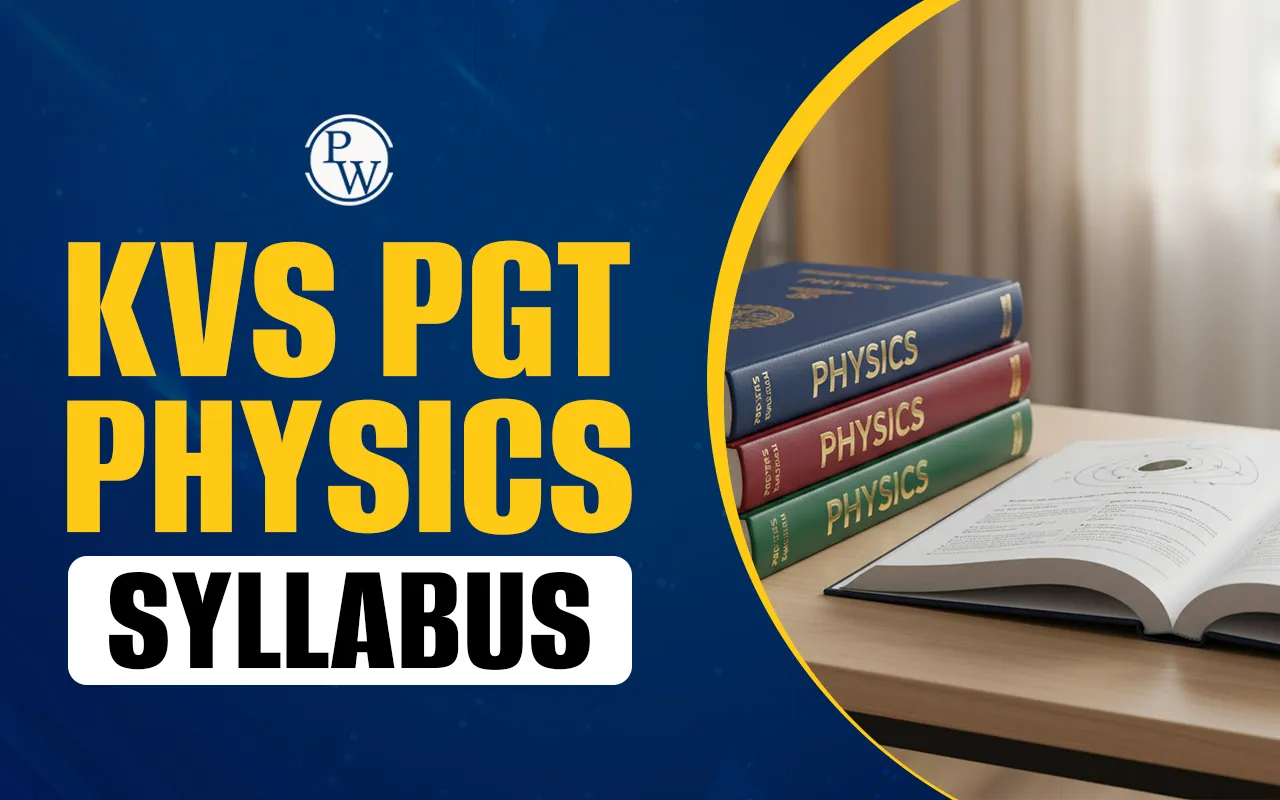

KVS PGT Physics Syllabus 2025 is an important guide for every student who wants to prepare for the KVS Post Graduate Teacher Physics exam. The syllabus explains the chapters, concepts, and topics that students must study before the exam. It also helps in planning revision in a clear and organised way. Many students look for a simple explanation of the KVS PGT Physics Syllabus 2025, so this article explains everything in a child-friendly and easy-to-read manner.
Students who wish to teach Physics in Kendriya Vidyalayas should understand the KVS Notification 2025, the exam pattern, syllabus format, and marking system. With proper planning and steady practice, the KVS PGT Physics Syllabus 2025 becomes easy to manage.
KVS PGT Recruitment 2025
The recruitment process for KVS PGT posts follows the guidelines mentioned in the KVS Notification 2025. This exam selects teachers for Physics at the senior secondary level. Candidates who want to apply must know the eligibility requirements and the full recruitment structure given in the KVS PGT Recruitment 2025 details.
The KVS Notification 2025 includes information on age limits, qualification rules, exam mode, and selection steps. The KVS PGT Recruitment 2025 follows an online application process and includes a computer-based exam.
| KVS PGT Recruitment 2025 | |
| Particular | Details |
| Organisation | Kendriya Vidyalaya Sangathan |
| Conducting Body | CBSE |
| Post Name | Post Graduate Teacher (PGT) – Physics |
| Mode of Exam | Computer-Based Test |
| Selection Process | Written Test + Interview |
| Official Websites | cbse.gov.in, kvsangathan.nic.in |
KVS PGT Physics Syllabus PDF
Students can download the KVS PGT Physics Syllabus PDF to study the topics in an organised way. The PDF includes a complete list of chapters and subtopics. Reading the KVS PGT Physics Syllabus PDF makes it easy to revise the whole syllabus whenever required.
KVS PGT Physics Syllabus 2025 in PDF format helps students keep all Physics topics in one place. It supports smooth revision and is helpful for self-study. For easy access, the KVS PGT Physics Syllabus PDF is attached below.
KVS PGT Physics Syllabus 2025 (Unit Wise)
KVS PGT Physics Syllabus 2025 covers major topics from Class 11 and Class 12 Physics. These topics improve conceptual understanding and help students answer application-based questions. The syllabus includes Mechanics, Heat, Electricity, Magnetism, Optics, and Modern Physics.
Students must read every topic carefully because the exam checks both theoretical knowledge and problem-solving skills. Below is the complete list of chapters included in the KVS PGT Physics Syllabus 2025.
| KVS PGT Physics Syllabus 2025 | |
| Unit | Topics Included |
| Units and Measurements | Need for measurement; Units of measurement; systems of units; SI units, fundamental and derived units, significant figures. Dimensions of physical quantities, dimensional analysis and its applications. |
| Motion in a Straight Line | Frame of reference, Motion in a straight line, Elementary concepts of differentiation and integration for describing motion, uniform and non-uniform motion, instantaneous velocity, uniformly accelerated motion, velocity-time and position-time graphs, relations for uniformly accelerated motion. |
| Motion in a Plane | Scalar and vector quantities; position and displacement vectors, general vectors and their notations; equality of vectors, multiplication of vectors by a real number; addition and subtraction of vectors, unit vector; resolution of a vector in a plane, rectangular components, scalar and vector product of vectors. Motion in a plane, cases of uniform velocity and uniform acceleration, projectile motion, and uniform circular motion. |
| Laws of Motion | Intuitive concept of force, Inertia, Newton's laws of motion, momentum, impulse, law of conservation of linear momentum, equilibrium of concurrent forces, static and kinetic friction, rolling friction, and lubrication. Dynamics of uniform circular motion, centripetal force, and examples of circular motion. |
| Work, Energy and Power | Work done by constant and variable force, kinetic energy, work-energy theorem, power, potential energy, potential energy of a spring, conservative and non-conservative forces, motion in a vertical circle, elastic and inelastic collisions. |
| Motion of System of Particles and Rigid Body | Centre of mass of two-particle system, momentum conservation, centre of mass of rigid body, centre of mass of uniform rod, moment of force, torque, angular momentum, law of conservation of angular momentum, equilibrium of rigid bodies, rigid body rotation, rotational motion equations, comparison of linear and rotational motion, moment of inertia, radius of gyration, values for simple geometrical objects. |
| Gravitation | Kepler’s laws, universal law of gravitation, acceleration due to gravity and variation with altitude and depth, gravitational potential energy, gravitational potential, escape velocity, orbital velocity. |
| Mechanical Properties of Solids | Elasticity, Stress-strain relationship, Hooke's law, Young's modulus, bulk modulus, shear modulus, Poisson's ratio, elastic energy. |
| Mechanical Properties of Fluids | Pressure due to fluid column, Pascal's law and applications, viscosity, Stokes' law, terminal velocity, streamline and turbulent flow, critical velocity, Bernoulli’s theorem, surface energy, surface tension, angle of contact, pressure across curved surface, droplets, bubbles, capillary rise. |
| Thermal Properties of Matter | Heat, temperature, thermal expansion, anomalous expansion of water, specific heat, Cp, Cv, calorimetry, latent heat, heat transfer (conduction, convection, radiation), thermal conductivity, Blackbody radiation, Wein’s Law, Stefan’s Law. |
| Thermodynamics | Thermal equilibrium, temperature, Zeroth law, heat, work, internal energy, First law, Second law, isothermal, adiabatic, reversible, irreversible and cyclic processes. |
| Kinetic Theory | Perfect gas law, work done on gas, kinetic theory assumptions, pressure concept, kinetic interpretation of temperature, rms speed, degrees of freedom, law of equipartition of energy, mean free path, Avogadro number. |
| Oscillations and Waves | Periodic motion, time period, frequency, displacement-time function, SHM, equations of SHM, phase, spring oscillations, energy in SHM, simple pendulum, transverse and longitudinal waves, wave speed, progressive wave equation, superposition, reflection, standing waves, harmonics, beats. |
| Electric Charges and Fields | Electric charge, conservation, Coulomb law, superposition, electric field, field due to point charge, electric lines, dipole field, torque on dipole, electric flux, Gauss theorem and applications. |
| Magnetism and Matter | Bar magnet, solenoid (qualitative), dipole field (qualitative), torque on dipole, magnetic field lines, magnetic materials, magnetisation, temperature effects. |
| Electromagnetic Induction and AC | Faraday laws, induced EMF, Lenz law, self and mutual induction, alternating current, RMS and peak value, reactance, impedance, LCR circuit, resonance, AC power, power factor, wattless current, AC generator, transformer. |
| Electromagnetic Waves | Displacement current, EM waves, properties, transverse nature, EM spectrum and uses. |
| Ray Optics and Optical Instruments | Reflection, spherical mirrors, mirror formula, refraction, TIR, optical fibres, refraction at spherical surface, lenses, lens formula, lens maker formula, magnification, power of lens, combination of lenses, prism, microscopes, telescopes, magnifying power. |
| Wave Optics | Wavefront, Huygens principle, reflection, refraction, interference, YDSE, fringe width, coherence, diffraction, central maximum. |
| Dual Nature of Radiation and Matter | Photoelectric effect, Einstein equation, matter waves, de Broglie relation. |
| Atoms and Nuclei | Scattering experiment, Rutherford model, Bohr model, radius, velocity and energy of electron, spectra, nucleus, binding energy, nuclear fusion and fission. |
| Semiconductor Electronics | Energy bands, intrinsic and extrinsic semiconductors, p-n junction, diode characteristics, and diode as a rectifier. |
KVS PGT Physics Exam Pattern
KVS PGT Mathematics Exam Pattern 2025 includes two written stages followed by an interview. The written stages consist of Tier-1 and Tier-2, each designed to assess different levels of understanding. Tier-1 is a qualifying level, while Tier-2 evaluates the applicant’s conceptual clarity and subject knowledge. The final merit list is prepared by considering the performance in Tier-2 and the interview.
KVS PGT Mathematics Tier-1 Exam Pattern 2025
Tier-1 is the first step of the recruitment process. This level helps in screening the candidates for the next stage. Although it is qualifying in nature, it plays an essential role because only those who achieve more than the required cutoff can appear for Tier-2.
Tier-1 is conducted in an objective OMR-based format. Every question is multiple-choice, and each correct response carries equal weightage. The paper includes 100 questions for a total of 300 marks, and the duration is 2 hours.
| KVS PGT Mathematics Tier-1 Exam Pattern 2025 | |||
| Test Component | No. of Questions | Total Marks | Duration |
| Part I – General Reasoning | 20 | 60 | 2 Hours (Total) |
| Part II – Numeric Ability | 20 | 60 | |
| Part III – Basic Computer Literacy | 20 | 60 | |
| Part V – Language Competency (English) | 10 | 30 | |
| Part VI – Language Competency (Modern Indian Language) | 10 | 30 | |
| Total | 100 | 300 | 2 Hours |
KVS PGT Mathematics Tier-2 Exam Pattern 2025
Tier-2 is the core examination stage and holds greater weightage in the final selection. The purpose of this level is to assess deeper subject knowledge in Mathematics. The exam is conducted in a combined pen-paper and OMR-based form.
The duration of the Tier-2 exam is 2.5 hours, and the total marks assigned are 100. It includes objective as well as descriptive questions to evaluate conceptual understanding, logical approach, clarity of explanation, and writing ability.
| KVS PGT Mathematics Tier-2 Exam Pattern 2025 | ||||
| Components of Test | Type of Questions | No. of Questions | Total Marks | Duration |
| Subject Knowledge | Objective | 60 | 60 | 2.5 Hours (Total) |
| Subject Knowledge | Descriptive | 10 | 40 | |
| Total | — | 70 | 100 | 2.5 Hours |
